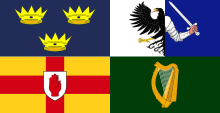Dobhar-chú
The Dobhar-chú (Irish pronunciation: [ˈd̪ˠaɾˠxuː], lit. "water dog" or "water hound") or King Otter is a creature of Irish folklore. It resembles both a dog and an otter, though it sometimes is described as half dog, half fish. It lives in water and has fur with protective properties.
| Grouping | Legendary creature |
|---|---|
| Sub grouping | Lake and river |
| Other name(s) | King Otter |
| Country | Ireland |
| Part of a series on the |
| Culture of Ireland |
|---|
 |
| History |
| People |
|
|
Cuisine
|
| Religion |
| Art |
| Literature |
|
Music and performing arts
|
|
Media
|
|
Monuments |
|
Symbols
|
|
Description
Physical description of the resembles an otter but said to be about five times as large (perhaps 10–15 feet), with white pelt, black ear tips and a black cross on its back. [1]
Etymology
Dobharchú is an obsolete Irish word for 'otter'. The modern Irish word for water is 'uisce' although 'dobhar' is also (rarely) used. 'Dobhar' is a much older form and cognates are found in other Celtic languages (e.g. Welsh, 'dwr', water). 'Cú' is 'hound' in Irish (see, for example, 'Cúchulainn', the hound of Culainn).The Dobhar-chú is also known as the "dobarcu", and anglicised as "doyarchu", "dhuragoo / dorraghow" "anchu".[2]
Headstone
A headstone, found in Conwall cemetery in Glenade, County Leitrim, depicts the Dobhar-chú and is related to a tale of an attack on a local woman by the creature.[3] The stone is claimed to be the headstone of a grave of a woman killed by the Dobhar-chú in the 17th century.[4]
The monument is a recumbent flag of sandstone about 4 ft. 6ins. by 1 ft. 10 ins. It shows a recumbent animal having body and legs like those of a dog with the characteristic depth of rib and strength of thigh. The tail, long and curved, shows a definite tuft. The rear of the haunch, and still more the tail, are in exceptionally low relief, apparently due the loss of a thin flake from the face of the slab. So far the description is canine. The lettering, and carving are in relief. [2]
Incident
Her name was supposedly Grace McGloighlin. Her husband supposedly heard her scream as she was washing clothes down at Glenade Lough and came to her aid. When he got there she was already dead, with the Dobhar-chú upon her bloody and mutilated body. The man killed the Dobhar-chú, stabbing it in the heart. As it died, it made a whistling noise, and its mate arose from the lough. Its mate chased the man but, after a long and bloody battle, he killed it as well.[5]
See also
- Ahuizotl (creature)
- Kelpie (Water Horse)
- Lake monster
- Lavellan
- Selkie
References
- O'Flaherty, Roderic (1846). A Chorographical Description of West Or H-Iar Connaught: Written A.D. 1684. For the Irish Archaeological Society.
- Tohall, Patrick (1948). "The Dobhar-Chú Tombstones of Glenade, Co. Leitrim (Cemetries of Congbháil and Cill-Rúisc)". The Journal of the Royal Society of Antiquaries of Ireland. 78 (2): 127–129. ISSN 0035-9106.
- Tohall, Patrick (December 1948). "The Dobhar-Chú Tombstones of Glenade, Co. Leitrim (Cemetries of Congbháil and Cill-Rúisc)". Journal of the Royal Society of Antiquaries of Ireland. 78 (2): 127–129.
- von Radowitz, John (November 10, 2017). "Does prehistoric otter explain Dobhar-chú myth?". Independent. Retrieved 11 March 2020.
- "The tale of Leitrim's own Loch Ness Monster - the Dobhar-Chú". Leitrim Observer. September 6, 2018. Retrieved 11 March 2020.